 Thetime had finally come to replace the engines on my 1979 Piper Aerostar. N6069N’s leftengine had gone past its 1800-hour published TBO, and the right one was rapidlyapproaching that number. Both engines were running as well as they ever did, and AVwebeditor Mike Busch kept advising me to keep flying until the engines started showing signsof being tired. But, I had more than just engine time in mind when I decided to take theplunge.
Thetime had finally come to replace the engines on my 1979 Piper Aerostar. N6069N’s leftengine had gone past its 1800-hour published TBO, and the right one was rapidlyapproaching that number. Both engines were running as well as they ever did, and AVwebeditor Mike Busch kept advising me to keep flying until the engines started showing signsof being tired. But, I had more than just engine time in mind when I decided to take theplunge.
The Aerostar Corporation, now located in Coeur d’Alene, Idaho, had developed an STC toconvert the standard Aerostar 601P engines (290 HP turbonormalized Lycoming IO-540-S1A5s)to 350 HP turbo-boosted Lycoming TIO-540-U2As. My airplane didn’t have stock enginesexactly – I’d installed a shorter prop that increased RPM redline to 2700, raisingtakeoff power to 300 HP – but the new STC still offered me a total increase of 50 HP aside. The new engines promised quite a performance boost to an already fast airplane.
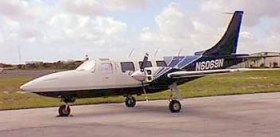 While Aerostars are fast airplanes, they’re not exactly known for theirshort-field takeoff capability. As my airplane approached max gross takeoff weight, itbecame quite a ground lover on takeoff. I lighten the nosewheel at 85 knots and rotate at95 knots, then wait what seems forever to reach best single engine rate of climb speed(blue line) of 117 knots. Initial climb, particularly at max weight on a warm day, is poorenough to make Aerostar pilots wonder what it would be like with only one engine turning.I hope I never find out while I am low and slow.
While Aerostars are fast airplanes, they’re not exactly known for theirshort-field takeoff capability. As my airplane approached max gross takeoff weight, itbecame quite a ground lover on takeoff. I lighten the nosewheel at 85 knots and rotate at95 knots, then wait what seems forever to reach best single engine rate of climb speed(blue line) of 117 knots. Initial climb, particularly at max weight on a warm day, is poorenough to make Aerostar pilots wonder what it would be like with only one engine turning.I hope I never find out while I am low and slow.
I decided that adding 50 HP a side should make quite a difference, and decided not towait any longer.
Pros and cons of the new engines
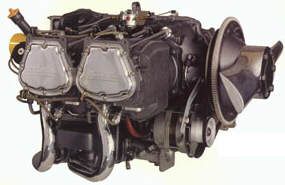 The new engines did make a big difference. With 700 HP nowpowering 69N, it spends less time on the runway, and reaches blue line speeds almost assoon as the gear is in the wells. Initial climb is always better than 1000 fpm andimproves as the airplane climbs until above 16,000 feet where the rate of climb startsdecreasing, reaching about 600-700 fpm at FL250. Pretty impressive. The takeoff and climbcharacteristics of the plane have been transformed from mediocre to spectacular and safetyhas been increased substantially. While an engine failure would not be good early afterliftoff, it is now going to be more manageable than it was before the engine change.
The new engines did make a big difference. With 700 HP nowpowering 69N, it spends less time on the runway, and reaches blue line speeds almost assoon as the gear is in the wells. Initial climb is always better than 1000 fpm andimproves as the airplane climbs until above 16,000 feet where the rate of climb startsdecreasing, reaching about 600-700 fpm at FL250. Pretty impressive. The takeoff and climbcharacteristics of the plane have been transformed from mediocre to spectacular and safetyhas been increased substantially. While an engine failure would not be good early afterliftoff, it is now going to be more manageable than it was before the engine change.
Cruise speed with the new engines ranges from fast to blistering, dependending on whatpower setting I choose. At altitude, 75% produces 240-250 knots, 65% gives 220-230 knots,and 55% yields 210-220 knots (all depending on aircraft weight and flight conditions, ofcourse).
Now for the bad news: the fuel burn is out of sight!
My 300 HP engines consumed 16.5-17.0 GPH per side at about 65% power, with TurbineInlet Temperatures (TITs) running at a cool 1550F (100F below redline). Cylinder headtemps also ran cool at 350F.
With the new engines, things were very different: At 75% power, they gobbled anastonishing 24 GPH per side with the TITs running jut over 1600F and the cylinder headsrunning near 400F degrees. While these temps were below redline, I couldn’t imaginethey’d be good for the longevity of my expensive new engines. Reducing power to 65%brought CHTs down slightly to the high 300’s and the fuel flows to 22 GPH per side. Stillhot and still not exactly economical. Trying the “economy setting” of 55%reduced the head temperatures to about 375F, but the TITs remained around 1600F andthe fuel flows were still about 20.5 GPH per side, nearly 8 GPH more than the old enginesused at 65%.
It was pretty clear that the fuel efficiency of the new engines was substantially worsethan the old ones. With my new engines, 55% of 350 HP is 192 HP. With the old engines, 65%of 300 HP is 195 HP, about the same horsepower. Sure enough, I was getting the sameairspeeds with the new engines at 55% as with the old ones at 65%. But the new engineswere burning 8 GPH more! The 8 GPH was bad news for two reasons: it increased theoperating cost, and more importantly it reduced my range significantly. On a four-hourtrip I was using 32 more gallons than before significantly reducing my range. Look at thenumbers:
Old 300 HP engines | New 350HP engines | |||||
|---|---|---|---|---|---|---|
| Time | GPH | Gallons | Time | GPH | Gallons | |
| Climb | :35 | 52 | 30 | :25 | 68 | 27 |
| Cruise | 3:25 | 33 | 113 | 3:35 | 41 | 146 |
| Trip Totals | 4:00 | 36 | 143 | 4:00 | 43 | 173 |
| Reserve | 2:00 | – | 67 | 0:54 | – | 37 |
So after 4:00 hrs of flying, I used to have a 2-hour reserve, now (even using a miserly55% cruise setting) I’m down to less than one hour. My old five-hour-with-reservesairplane with had become a four-hour-with-reserves airplane. I’d lost about one hour ofendurance, which at 220 knots is 220 nm less range than before. I was not happywith these numbers.
GAMIjectors to the rescue!
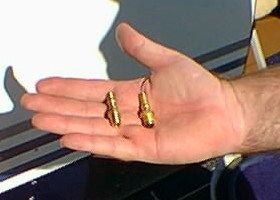 General Aviation Modifications, Inc. of Ada, Oklahomahas been making balanced fuel injectors for Continental engines for a few years (seeMike Busch’s review article). Recently, they announced FAAapproval of GAMIjectors for Lycoming engines, and their STC included the new TIO-540-U2Asin my Aerostar. I knew about George Braly’s team in Oklahoma and what they have done forContinental-powered airplanes, and I hoped their new Lycoming GAMIjectors might help myfuel consumption crisis.
General Aviation Modifications, Inc. of Ada, Oklahomahas been making balanced fuel injectors for Continental engines for a few years (seeMike Busch’s review article). Recently, they announced FAAapproval of GAMIjectors for Lycoming engines, and their STC included the new TIO-540-U2Asin my Aerostar. I knew about George Braly’s team in Oklahoma and what they have done forContinental-powered airplanes, and I hoped their new Lycoming GAMIjectors might help myfuel consumption crisis.
Prior to flying to Ada, I visited GAMIjectors web siteand downloaded the leaning test sheet. In order to balance the fuel flows to each of yourcylinders, GAMI needs to know what the flows are to each cylinder and at what flow eachcylinder reaches peak EGT. GAMI’s goal is to tweak your injectors so that each cylinderreaches peak EGT at the same time (i.e., at the same mixture-control setting).
 GAMI’sleaning test procedure doesn’t ask for specific EGT temperature readings, because theydon’t matter. All GAMI needs to know is the fuel flow at which each individual cylinderreach peak EGT. (You must have probe-per-cylinder EGT instrumentation such as a GEM or JPI700 in order to obtain this information.) Specific temperatures will depend on EGT probelocation, instrument calibration and internal cylinder differences; but peak EGT signifiesthat the “stoichiometric” fuel/air ratio has been reached. Cooler-than-peak onthe rich side indicates excessive fuel, and cooler-than-peak on the lean side indicatesexcessive air. Conventional wisdom (and some engine manuals) advise cruising at 25F to75F rich of peak, using the extra fuel in the mixture to provide additional cooling.
GAMI’sleaning test procedure doesn’t ask for specific EGT temperature readings, because theydon’t matter. All GAMI needs to know is the fuel flow at which each individual cylinderreach peak EGT. (You must have probe-per-cylinder EGT instrumentation such as a GEM or JPI700 in order to obtain this information.) Specific temperatures will depend on EGT probelocation, instrument calibration and internal cylinder differences; but peak EGT signifiesthat the “stoichiometric” fuel/air ratio has been reached. Cooler-than-peak onthe rich side indicates excessive fuel, and cooler-than-peak on the lean side indicatesexcessive air. Conventional wisdom (and some engine manuals) advise cruising at 25F to75F rich of peak, using the extra fuel in the mixture to provide additional cooling.
Lycomings are different
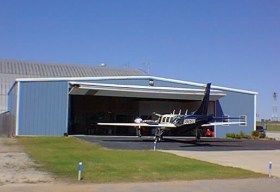 Due to the configuration of the runner-and-riserinduction system used by most Continental engines, the individual cylinder air/fuel ratiosare predictably different – the rearmost cylinders generally run lean and thefrontmost ones run rich. GAMIjectors solve this problem by providing flow-balancinginjectors that use slightly larger orifices in the rear cylinders and slightly smallerones in the front cylinders. The result is an engine in which all cylinders reach peak EGTat the same mixture control setting. Because the fuel imbalance in Continentals engines isso predictable, this “standard” approach works almost all the time withContinentals. “When it doesn’t work, we usually find something else wrong with theinduction system like intake leaks, exhaust leaks, and so forth,” George Braly toldme.
Due to the configuration of the runner-and-riserinduction system used by most Continental engines, the individual cylinder air/fuel ratiosare predictably different – the rearmost cylinders generally run lean and thefrontmost ones run rich. GAMIjectors solve this problem by providing flow-balancinginjectors that use slightly larger orifices in the rear cylinders and slightly smallerones in the front cylinders. The result is an engine in which all cylinders reach peak EGTat the same mixture control setting. Because the fuel imbalance in Continentals engines isso predictable, this “standard” approach works almost all the time withContinentals. “When it doesn’t work, we usually find something else wrong with theinduction system like intake leaks, exhaust leaks, and so forth,” George Braly toldme.
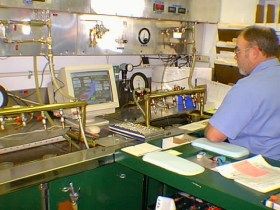 But Lycoming engines do not have the same predictableimbalances. The main reason Lycoming engine cylinders do not reach peak at the same timeis the sloppy tolerances in their fuel injectors. Consequently, GAMI has to custom-balancethe injectors for each individual Lycoming engine.
But Lycoming engines do not have the same predictableimbalances. The main reason Lycoming engine cylinders do not reach peak at the same timeis the sloppy tolerances in their fuel injectors. Consequently, GAMI has to custom-balancethe injectors for each individual Lycoming engine.
I supplied GAMI with the engine fuel flows at which each cylinder on each of my enginespeaked. It varied considerably, but “was pretty good” as Lycomings go, accordingto GAMI.
GAMI’s goal was to provide me with a custom set of fuel injectors that would make eachcylinder peak at the same time. The first step was for GAMI to remove my stock Lycomingfuel injectors and measure their actual fuel flow, using a sophisticated computerized flowbench. This step told GAMI engineers exactly what was happening in my engine to cause thecylinders to reach peak at different times.
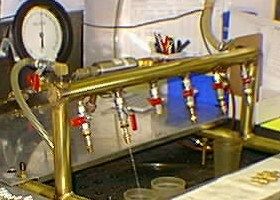 Then, using a proprietary computer program based on myleaning results and my injector measurements, GAMI selected a custom-matched set of fuelinjectors for each cylinder on each engine. These were flow-checked on GAMI’s flow benchand final fine adjustments were made (by hand reaming the injectors to the precise flowspecified by the program). Then the new injectors were installed on my engines, and theairplane was test-flown to verify the results.
Then, using a proprietary computer program based on myleaning results and my injector measurements, GAMI selected a custom-matched set of fuelinjectors for each cylinder on each engine. These were flow-checked on GAMI’s flow benchand final fine adjustments were made (by hand reaming the injectors to the precise flowspecified by the program). Then the new injectors were installed on my engines, and theairplane was test-flown to verify the results.
Since each injector is custom-sized to its particular cylinder, a data plate isinstalled on each cylinder to indicate which injector goes where. After routine injectorcleaning, it’s vital that each injector be returned to its proper cylinder – they’re nolonger interchangeable.
But does it help?
So now I have a set of engines that have almost perfectly balanced fuel/air ratios forevery cylinder. How does that help?
Actually, the GAMIjectors don’t help much so long as the same oldrich-of-peak leaning procedures are used. The real benefit of the new injectors is thatthey allow me to lean the engines far more aggressively than before, and run them in thelean-of-peak regime. Before installing the GAMIjectors, I didn’t have that option becausethe engines would start running rough if I tried leaning them that far.
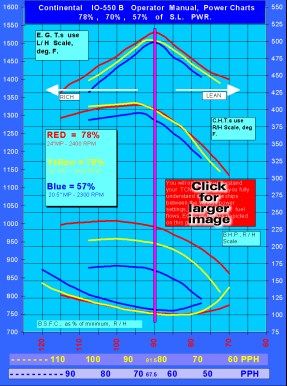 Here’s why. When an engineis operating on the rich side of peak, small variations in mixture don’t have much effecton power output. If some cylinders are running 75F rich of peak and others are running25F rich of peak, they’re still producing about the same horsepower and so the engineruns smoothly. Even with uneven fuel flows, most engines won’t start running rough so longas you stay on the rich side of peak.
Here’s why. When an engineis operating on the rich side of peak, small variations in mixture don’t have much effecton power output. If some cylinders are running 75F rich of peak and others are running25F rich of peak, they’re still producing about the same horsepower and so the engineruns smoothly. Even with uneven fuel flows, most engines won’t start running rough so longas you stay on the rich side of peak.
But what happens if we move to the lean side of peak EGT? As you can see from theaccompanying graph, both horsepower and CHT starts dropping off fairly rapidly as themixture gets leaner. In fact, on the lean side of peak, horsepower varies almostproportionally with fuel flow. (As a rule of thumb, HP is equal to about 14 times GPH.Stash this tidbit away for later…we’ll come back to it.)
If you lean a “stock” Lycoming engine lean of peak, it starts running rough.Why? Because some cylinders are running richer (say 25F lean of peak) and others arerunning leaner (say 75F lean of peak), so their power outputs are noticeably different.These horsepower imbalances between cylinders are perceived as a “rough-runningengine.” But with properly flow-balanced GAMIjectors, the cylinders run atnear-identical mixtures, and put out near-identical horsepower. The net result is that youcan lean the engine well into the lean-of-peak regime without any onset of roughness.
We’re now ready for the unconventional wisdom: lean-of-peak operation. If we lean toabout 50F lean of peak, CHTs run some 25F cooler than they do at peak. The EGTs at50F lean of peak are the same as they are at 50F rich of peak, of course. Thehorsepower produced at 50F lean of peak is somewhat lower, so we compensate for that bybringing up the manifold pressure by 2 or 3 inches restore the lost power. The result isthat the engine puts out the same horsepower at lower fuel flow and cooler CHTs. Whichsounds like a good thing, doesn’t it?
Is this legal? Is it wise? Will it hurt anything? GAMI has found this excerpt from aLycoming 540 engine manual:
Lean the mixture until EGT peaks and continue to lean until [the EGT] drops 25 to 50 degrees on the gauge. Flying on the lean side is permissible if extended range and cooler engines are desired. Operation at peak EGT is only recommended for mixture control adjustments or when induction icing occurs. [The] amount of temperature drop can be determined by resultant fuel consumption and engine smoothness.
When operating on the lean side of the power curve, the pilot may observe that airspeed and power are less. If you desire to regain lost airspeed and continue to fly on the lean side of the curve, two steps are important. If sufficient throttle is available at the lower altitudes; first add two inches of manifold pressure to the standard cruise setting and then lean 25 to 50 degrees (lean of peak). Occasionally, some pilots prefer to fly on the rich side of the power curve; this is permissible. Adjust the mixture until EGT peaks and then enrich mixture until you get 25 to 50 degree drop on the EGT gauge. Acceptable continuous (cylinder) head temperature is an important reference here.
To sum up: according to the chart and Lycoming’s own explanation quoted above, running25F to 50F lean of peak EGT will result in lower CHTs, lower fuel consumptionand slightly reduced power (which can be restored by increasing manifold pressure 2-3inches). Because the power curve drops sharply on the lean side of peak, the engine willrun more roughly lean of peak unless all the cylinders are on the same part of thecurve (and thus producing the same horsepower). This will only happen if the fuel/airratios are closely matched for all the cylinders.
That’s why you need the matched GAMIjectors.
Actual results
 In my Aerostar with the 350 HP engines equipped with GAMIjectors, I havefound that I can fly at about 75F lean of peak without losing too much power. Peak TITdepends on altitude – the higher I go, the higher the peak TIT at any given power (asexpected). The limiting factor is the 1650F TIT limit, so at higher altitudes I willhave to run at reduced power settings in order to keep the TITs below redline.
In my Aerostar with the 350 HP engines equipped with GAMIjectors, I havefound that I can fly at about 75F lean of peak without losing too much power. Peak TITdepends on altitude – the higher I go, the higher the peak TIT at any given power (asexpected). The limiting factor is the 1650F TIT limit, so at higher altitudes I willhave to run at reduced power settings in order to keep the TITs below redline.
For example, at FL180, 65% power (2200 RPM and 32″ MP) burns 21 GPH per side andyields a TIT of about 1600F with CHTs about 360F if I lean the old way (rich of peak).With the GAMIjectors, I can continue leaning past peak EGT to a miserly 16 GPH without anyengine roughness, which yields TITs of about 1640F and CHTs about 335F. Adding acouple of inches to the manifold pressure (to 34″) to restore the lost power doesn’tseem to affect these temps. Note that the CHTs are extremely cool and the fuel flows farlower than before, but the TITs are running close to the limit and are definitely thelimiting factor.
Where’d that 16 GPH figure come from? Well, 65% of 350 HP is about 227 HP. Using themagic HP=14*GPH formula I mentioned earlier, fuel flow at 227 HP should be 227 divided by14 or 16.2 GPH.
At lower altitudes, the TITs are not as close to 1650F, and the CHTs run cooler yet!At higher altitudes, I have to reduce cruise power to 55% or 60% to keep the TITs belowredline. Reducing RPM to 2100 at the lower power settings helps lower the TITs.
When I mentioned to George Braly of GAMI that I was uncomfortable with such high TITs,George pointed out that since my airplane has an all-Inconel exhaust system (which canhandle 2100F temps), the only real disadvantage of running near-redline would be that itmight shorten the life of my turbochargers somewhat (due to accelerated turbine wheel”blade stretch” at those high temperatures). But he pointed out that with the 10GPH fuel saving per hour, I would save $20/hr or $20,000 per 1,000 hours of operation.With that kind of savings, maybe I could put up with slightly reduced turbocharger life.At the same time, the dramatically lower CHTs that result from lean-of-peak operationshould produce longer cylinder life. Since a turbocharger overhaul costs only a smallfraction of what a top overhaul does, this seems like a pretty good tradeoff.
So, I have gotten my range back, reduced cruise fuel flows, and lowered cruise CHTs allat the expense of slightly higher TITs and some one-time expense for the GAMIjectors. Allgood tradeoffs I think. The engines run smoothly at 75F lean of peak and my speeds areabout 10 knots below book speeds for the power settings I have chosen. I now have choices:
- run at higher power and higher speeds at the cost of high fuel flows and high CHTs,
- run at somewhat reduced power and lower all temps and fuel flows a little, or
- run at reduced power lean of peak and reduce fuel flows significantly, increase range, lower CHTs all at the expense of higher TITs.
The lean-of-peak controversy
Doeseveryone agree that running the engines this way is a good thing? No. There are many(including certain engine overhaul shops) who are dead set against running on the leanside of peak and will blame any engine problems on that practice.
One school of thought is that on the lean side of peak there is less fuel and moreoxygen, and in theory that could lead to more oxidation, possibly of the cylinder walls orvalve assemblies, and contribute to increased wear. GAMI says it has seen no evidencewhatsoever to validate this theory, and that the effect of any increase in oxygen oncylinders and valves would be more than offset by reduced operating temperatures.
Others insist that since the practice is not specifically spelled out in the Lycomingoperating manual for their particular engine model, they must conclude that running leanof peak has not been endorsed by the manufacturer. But if temperature limits are respectedand power settings are such that detonation is not a problem, it’s hard to see howLycoming would object to leaning aggressively.
GAMIjectors has run their own engines this way for several years and many hundreds ofhours, and their customers have done the same for tens of thousands of hours(cumulatively) with the same excellent results. “The engines look better running leanof peak than we would normally expect them to look using more traditional methods ofleaning,” GAMI’s service department told us.
When I mentioned that most pilots would prefer not to be guinea pigs for a new methodof engine management, GAMI pointed out that back in the days of piston-powered airliners,the Wright Aeronautical Division (who produced the turbo-compound piston engines thatpowered the DC-6, DC-7 and the famous Lockheed Constellations) recommended that theseengines be operated on the lean side of peak to lower cylinder head temperatures, extendthe range of the aircraft and to avoid the possibility of detonation at high powersettings. Thousands of these planes flew for millions of hours using lean-of-peakoperation. So, says GAMI, when we fly in this fashion, we aren’t pioneers – we’rehistorians.
Editor’s Note
For more information, see the GAMI web site, and also read Mike Busch’s review of GAMIjectors for TCM engines here on AVweb.
|


































